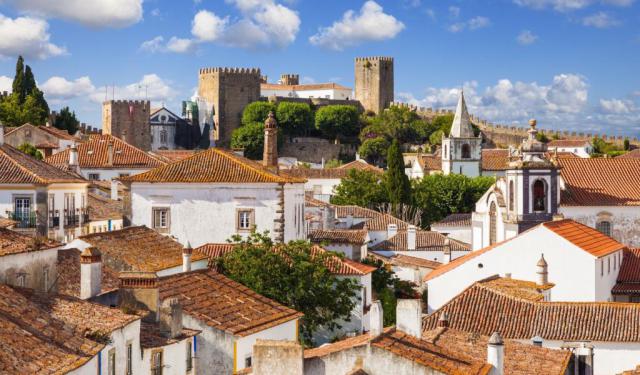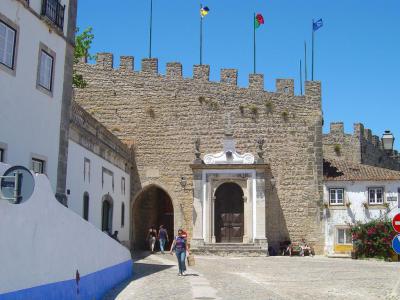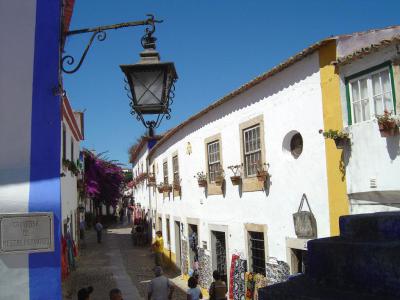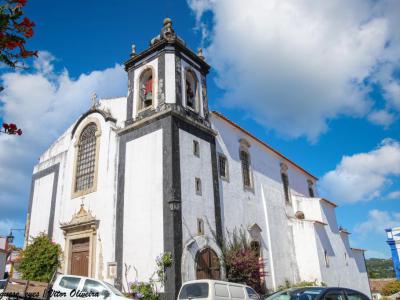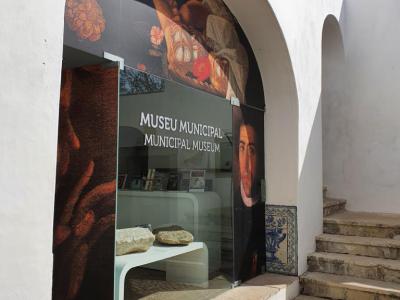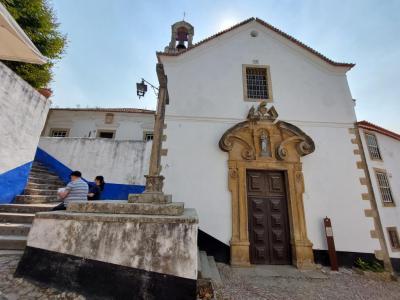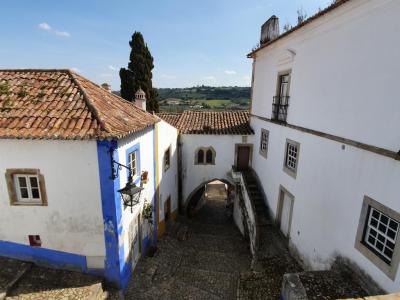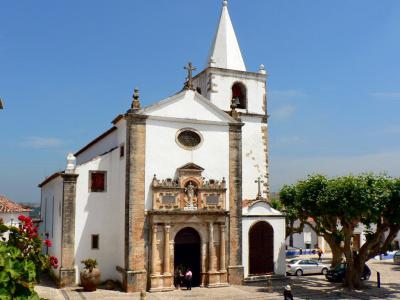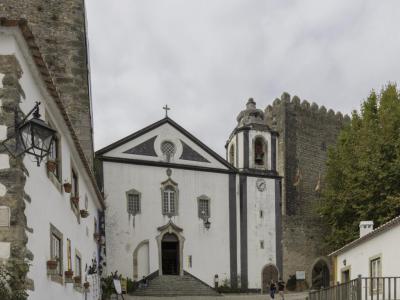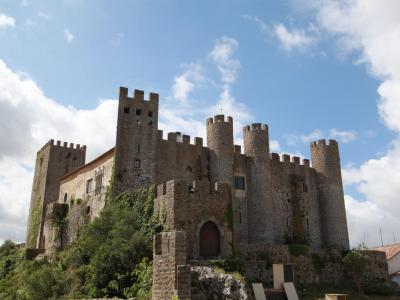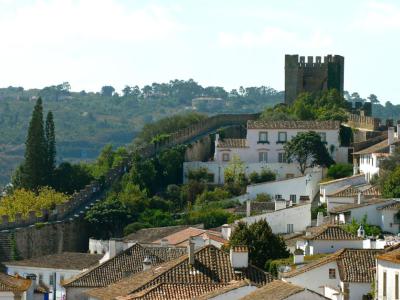Obidos Introduction Walking Tour (Self Guided), Obidos
An enchanting day trip option from Lisbon, the fortified town of Óbidos, perched gracefully atop a limestone ridge, is one of the premier tourist destinations in central Portugal.
Adding to the town's quaint allure is its illustrious past. Óbidos grew from a Roman settlement near an elevated escarpment when it was known as "Eburobrittium". Over the centuries, the name evolved into "Óbidos," possibly deriving from the Latin word "oppidum," which means citadel.
Once a hub for Phoenician trade with traces of Roman influence, such as a forum and baths, Óbidos thrived under Visigothic rule until the Moorish occupation, around 713 AD. In 1148, Óbidos was reclaimed from the Moors.
The town received its first charter in 1195 and was subsequently patronized by Portuguese queens, earning the nickname "Town of the Queens" (Vila das Rainhas). From 1214 until the 19th century, there was a longstanding tradition to bestow Óbidos upon the queen of Portugal on her wedding day. This royal patronage has left an indelible mark on the town, preserving its unique and beguiling character.
The royals made significant enhancements to the majestic Castle of Óbidos, crowning the town's hill, as well as to the town walls (Muralha de Óbidos). The Church of Santa Maria (Igreja de Santa Maria) witnessed the wedding of King Afonso V and Princess Isabella of Coimbra in 1441.
One of the most iconic landmarks of Óbidos is the so-called Village Gate (Porta da Vila). Passing through it, you will find yourself on Right Street (Rua Direita), a charming cobbled thoroughfare lined with whitewashed houses adorned with colorful bougainvillea, quaint shops, and cozy cafes.
As you explore Óbidos, you'll discover a treasure trove of historical and architectural gems, such as the Municipal Museum, housed in a former 16th-century prison, and the distinctive House of the Chain Arch (Casa do Arco da Cadeia).
The spiritual significance of Óbidos is evident in local churches, including the 13th-century Church of Saint Peter (Igreja de São Pedro), the Church of Mercy (Igreja da Misericórdia), and the Church of Saint James (Igreja de Santiago).
Today, Óbidos proudly stands as a picturesque jewel in Portugal's crown, where every corner seems to hold a piece of Portugal's past. The town beckons visitors to experience its enchanting beauty. We, too, invite you to embark on this self-guided journey through time. Wander its charming streets, explore its historic sites, and savor its unique atmosphere.
Adding to the town's quaint allure is its illustrious past. Óbidos grew from a Roman settlement near an elevated escarpment when it was known as "Eburobrittium". Over the centuries, the name evolved into "Óbidos," possibly deriving from the Latin word "oppidum," which means citadel.
Once a hub for Phoenician trade with traces of Roman influence, such as a forum and baths, Óbidos thrived under Visigothic rule until the Moorish occupation, around 713 AD. In 1148, Óbidos was reclaimed from the Moors.
The town received its first charter in 1195 and was subsequently patronized by Portuguese queens, earning the nickname "Town of the Queens" (Vila das Rainhas). From 1214 until the 19th century, there was a longstanding tradition to bestow Óbidos upon the queen of Portugal on her wedding day. This royal patronage has left an indelible mark on the town, preserving its unique and beguiling character.
The royals made significant enhancements to the majestic Castle of Óbidos, crowning the town's hill, as well as to the town walls (Muralha de Óbidos). The Church of Santa Maria (Igreja de Santa Maria) witnessed the wedding of King Afonso V and Princess Isabella of Coimbra in 1441.
One of the most iconic landmarks of Óbidos is the so-called Village Gate (Porta da Vila). Passing through it, you will find yourself on Right Street (Rua Direita), a charming cobbled thoroughfare lined with whitewashed houses adorned with colorful bougainvillea, quaint shops, and cozy cafes.
As you explore Óbidos, you'll discover a treasure trove of historical and architectural gems, such as the Municipal Museum, housed in a former 16th-century prison, and the distinctive House of the Chain Arch (Casa do Arco da Cadeia).
The spiritual significance of Óbidos is evident in local churches, including the 13th-century Church of Saint Peter (Igreja de São Pedro), the Church of Mercy (Igreja da Misericórdia), and the Church of Saint James (Igreja de Santiago).
Today, Óbidos proudly stands as a picturesque jewel in Portugal's crown, where every corner seems to hold a piece of Portugal's past. The town beckons visitors to experience its enchanting beauty. We, too, invite you to embark on this self-guided journey through time. Wander its charming streets, explore its historic sites, and savor its unique atmosphere.
How it works: Download the app "GPSmyCity: Walks in 1K+ Cities" from Apple App Store or Google Play Store to your mobile phone or tablet. The app turns your mobile device into a personal tour guide and its built-in GPS navigation functions guide you from one tour stop to next. The app works offline, so no data plan is needed when traveling abroad.
Obidos Introduction Walking Tour Map
Guide Name: Obidos Introduction Walking Tour
Guide Location: Portugal » Obidos (See other walking tours in Obidos)
Guide Type: Self-guided Walking Tour (Sightseeing)
# of Attractions: 10
Tour Duration: 1 Hour(s)
Travel Distance: 0.7 Km or 0.4 Miles
Author: DanaOffice
Sight(s) Featured in This Guide:
Guide Location: Portugal » Obidos (See other walking tours in Obidos)
Guide Type: Self-guided Walking Tour (Sightseeing)
# of Attractions: 10
Tour Duration: 1 Hour(s)
Travel Distance: 0.7 Km or 0.4 Miles
Author: DanaOffice
Sight(s) Featured in This Guide:
- Porta da Vila (Village Gate)
- Rua Direita (Right Street)
- Igreja de São Pedro (Church of Saint Peter)
- Municipal Museum of Óbidos
- Igreja da Misericórdia (Church of Mercy)
- Casa do Arco da Cadeia (House of the Chain Arch)
- Igreja de Santa Maria (Church of Santa Maria)
- Igreja de Santiago (Church of St. James)
- Castle of Óbidos
- Muralha de Obidos (Obidos Town Walls)
1) Porta da Vila (Village Gate)
The Village Gate stands proudly as the primary gateway to Óbidos. Its design comprises two staggered gateways, a strategic architectural approach aimed at preventing direct cavalry charges-a common feature in Portuguese gothic castles.
Nestled between these gateways is a stunning balcony, once an oratory adorned with exquisite blue and white tile panels dating back to 1740. These tiles vividly depict scenes from the Passion of Christ, accompanied by an inscription paying homage to Our Lady of Sorrows, the town's patron saint. The tiles serve as an artistic tribute to “The Virgin, Our Lady conceived without original sin.” Adorning the ceiling above these remarkable tiles is a painted depiction of a crown of thorns.
Upon passing through the gate, one is greeted by the main street, Rua Direita, directly ahead, while a set of steps unfolds immediately to the left. For those without vertigo or mobility concerns, ascending these steps initiates a journey offering breathtaking panoramic views of the entire town from atop the walls.
Nestled between these gateways is a stunning balcony, once an oratory adorned with exquisite blue and white tile panels dating back to 1740. These tiles vividly depict scenes from the Passion of Christ, accompanied by an inscription paying homage to Our Lady of Sorrows, the town's patron saint. The tiles serve as an artistic tribute to “The Virgin, Our Lady conceived without original sin.” Adorning the ceiling above these remarkable tiles is a painted depiction of a crown of thorns.
Upon passing through the gate, one is greeted by the main street, Rua Direita, directly ahead, while a set of steps unfolds immediately to the left. For those without vertigo or mobility concerns, ascending these steps initiates a journey offering breathtaking panoramic views of the entire town from atop the walls.
2) Rua Direita (Right Street) (must see)
Right Street stands as the heartbeat of Óbidos, offering visitors a charming journey through the town's history and culture. Serving as the main and practically the only real street in Óbidos, Rua Direita weaves its way from the main Town Gate to the illustrious castle.
Despite its narrow confines, this picturesque street is a vibrant tapestry of colors, adorned with cascading geraniums and vibrant bougainvillea. Lined with an array of shops, restaurants, cafés, and quaint galleries, Rua Direita invites exploration and discovery. The street is not just a thoroughfare; it's a lively avenue where locals and visitors alike converge to indulge in the town's rich offerings.
For those seeking traditional handicrafts, unique souvenirs, or a taste of the renowned "Ginja de Óbidos" liqueur, Rua Direita is the go-to destination. The street effortlessly captures the essence of Óbidos' charm, making it an irresistible magnet for anyone strolling through the town.
While Rua Direita traces its origins back to the 1300s, it underwent expansions in the 16th and 17th centuries, preserving its architectural legacy. The street proudly displays many of its original Gothic portals and windows, providing a glimpse into the historical layers that define Óbidos.
As you navigate Rua Direita, you'll find yourself drawn towards the main square, a picturesque hub that hosts the town's principal church, Igreja de Santa Maria. This square serves as the backdrop for the Municipal Museum, adding a cultural touch to the vibrant atmosphere.
Despite its narrow confines, this picturesque street is a vibrant tapestry of colors, adorned with cascading geraniums and vibrant bougainvillea. Lined with an array of shops, restaurants, cafés, and quaint galleries, Rua Direita invites exploration and discovery. The street is not just a thoroughfare; it's a lively avenue where locals and visitors alike converge to indulge in the town's rich offerings.
For those seeking traditional handicrafts, unique souvenirs, or a taste of the renowned "Ginja de Óbidos" liqueur, Rua Direita is the go-to destination. The street effortlessly captures the essence of Óbidos' charm, making it an irresistible magnet for anyone strolling through the town.
While Rua Direita traces its origins back to the 1300s, it underwent expansions in the 16th and 17th centuries, preserving its architectural legacy. The street proudly displays many of its original Gothic portals and windows, providing a glimpse into the historical layers that define Óbidos.
As you navigate Rua Direita, you'll find yourself drawn towards the main square, a picturesque hub that hosts the town's principal church, Igreja de Santa Maria. This square serves as the backdrop for the Municipal Museum, adding a cultural touch to the vibrant atmosphere.
3) Igreja de São Pedro (Church of Saint Peter)
The Church of Saint Peter, initially Gothic in design, traces its origins to the 13th century, although the structure underwent numerous transformations across the centuries, particularly following the seismic events of 1531 and 1755.
The entrance, constructed in the 1600s, stands in contrast to the predominantly 18th-century architecture that characterizes the church. Within its hallowed walls, the esteemed local artist Josefa De Óbidos finds her eternal repose. Still, it remains uncertain if she was the creator of the remarkable 17th-century artwork on the church's right side, depicting Saint Peter receiving the keys to Heaven from Christ. The opulent gilded retable, a marvel of Portuguese Baroque craftsmanship, crafted between 1690 and 1705, adorns the space with its splendor.
The church hosts side altars dedicated to Our Lady of Piety from the 15th century, Our Lady of the Rosary from the 18th century, and Our Lady of Fátima dating back to the 1940s. Adjacent to this sacred space stands the intriguing Gothic Chapel of Saint Martin.
The entrance, constructed in the 1600s, stands in contrast to the predominantly 18th-century architecture that characterizes the church. Within its hallowed walls, the esteemed local artist Josefa De Óbidos finds her eternal repose. Still, it remains uncertain if she was the creator of the remarkable 17th-century artwork on the church's right side, depicting Saint Peter receiving the keys to Heaven from Christ. The opulent gilded retable, a marvel of Portuguese Baroque craftsmanship, crafted between 1690 and 1705, adorns the space with its splendor.
The church hosts side altars dedicated to Our Lady of Piety from the 15th century, Our Lady of the Rosary from the 18th century, and Our Lady of Fátima dating back to the 1940s. Adjacent to this sacred space stands the intriguing Gothic Chapel of Saint Martin.
4) Municipal Museum of Óbidos
The Municipal Museum stands as a captivating testament to the cultural heritage of Óbidos. Housed in a former 16th-century prison, this modest yet impressive museum offers a diverse collection of artifacts spanning archaeology, religious artwork, and decorative objects.
Among its treasures are medieval tapestries portraying scenes from the life of Saint Peter, once gracing the walls of the town's castle. The museum showcases religious statues, paintings, antique furniture, and household items, providing a comprehensive glimpse into the region's past.
A special room dedicated to the history of Óbidos' renowned cherry liqueur, ginjinha, offers insight into the town's cultural traditions.
With information presented in both Portuguese and English, the Municipal Museum invites visitors to leisurely explore and uncover the rich history and culture of this charming Portuguese town and its surroundings.
Among its treasures are medieval tapestries portraying scenes from the life of Saint Peter, once gracing the walls of the town's castle. The museum showcases religious statues, paintings, antique furniture, and household items, providing a comprehensive glimpse into the region's past.
A special room dedicated to the history of Óbidos' renowned cherry liqueur, ginjinha, offers insight into the town's cultural traditions.
With information presented in both Portuguese and English, the Municipal Museum invites visitors to leisurely explore and uncover the rich history and culture of this charming Portuguese town and its surroundings.
5) Igreja da Misericórdia (Church of Mercy)
The Church of Mercy, formerly recognized as the "Chapel of the Holy Spirit," has a rich and transformative history. Since its establishment in 1498, when Queen Leonor founded the local almshouse, the chapel evolved into a haven for the sick and destitute. The 17th-century reconstruction marked its role as a place of worship and sanctuary for the impoverished and infirm, many of whom found solace within the accompanying baroque annex.
Today, this hallowed space has shifted into a museum, showcasing an array of remarkable artworks. The interior boasts wooden sculptures of the Virgin from the 17th century, a vibrant painted flag from 1592, and a ceiling adorned with the Royal Crown. Additionally, the tomb of the Countess of Cavaleiros graces the space.
The entire interior is bedecked in exquisite hand-painted blue and yellow tiles, created between 1625 and 1678, while the Mannerist retable glimmers with the allure of gold leaf. The art collection includes paintings from the late 1620s and early 1630s. Notably, the exterior exhibits a ceramic image of the Virgin and Child on the portal, crafted in 1665.
A prominent large cross stands before the church, facing a distinctive brick structure with gothic elements that once served as the Obidos synagogue.
Today, this hallowed space has shifted into a museum, showcasing an array of remarkable artworks. The interior boasts wooden sculptures of the Virgin from the 17th century, a vibrant painted flag from 1592, and a ceiling adorned with the Royal Crown. Additionally, the tomb of the Countess of Cavaleiros graces the space.
The entire interior is bedecked in exquisite hand-painted blue and yellow tiles, created between 1625 and 1678, while the Mannerist retable glimmers with the allure of gold leaf. The art collection includes paintings from the late 1620s and early 1630s. Notably, the exterior exhibits a ceramic image of the Virgin and Child on the portal, crafted in 1665.
A prominent large cross stands before the church, facing a distinctive brick structure with gothic elements that once served as the Obidos synagogue.
6) Casa do Arco da Cadeia (House of the Chain Arch)
The House of the Chain Arch, a former prison in Óbidos, Portugal, is an unexpectedly charming structure. Once functioning as the Town Hall in the 14th and 15th centuries, it evolved over time to become the residence of painter and scenographer Abílio de Matos e Silva in the 20th century. Portions of his residence became the original site of the Municipal Museum, which has since been transformed into another museum, now named after Abílio.
Its gothic arch and windows make it an architectural gem visible from the terrace adjacent to Santa Maria Church. In 1958, Abílio acquired the Casa do Arco, inspired by his own artistic portrayal of "Óbidos Vila Antiga de Portugal" that featured two houses with arches in 1938.
Following restoration by Maria José Salavisa, his widow, the house was donated to the Óbidos City Council as a tribute to her husband. The space is open for visitation by appointment, serving as a tribute to both Abílio and Maria José.
Its gothic arch and windows make it an architectural gem visible from the terrace adjacent to Santa Maria Church. In 1958, Abílio acquired the Casa do Arco, inspired by his own artistic portrayal of "Óbidos Vila Antiga de Portugal" that featured two houses with arches in 1938.
Following restoration by Maria José Salavisa, his widow, the house was donated to the Óbidos City Council as a tribute to her husband. The space is open for visitation by appointment, serving as a tribute to both Abílio and Maria José.
7) Igreja de Santa Maria (Church of Santa Maria) (must see)
The Church of Santa Maria unfolds a captivating tale of history and artistic splendor. Located in the main square, this Renaissance gem holds a legacy that dates back to the Visigothic period, with its origins possibly rooted in that ancient era.
Classified as a Property of Public Interest since 1933, the church carries a heritage of significance. Tradition suggests that it may have originated during the Visigothic period, later transformed into a mosque during the Muslim occupation. However, historical certainty emerges when D. Afonso Henriques consecrated the church after the conquest of the town in 1148.
The medieval structure underwent significant transformations at the end of the 15th century and into the first quarter of the 16th century. The bell tower and the chapel of Nossa Senhora da Piedade, featuring the tomb crafted by Nicolau Chanterene, have endured through the centuries, preserving the mortal remains of D. João de Noronha and D. Isabel de Sousa.
In 1570, the church faced the threat of ruin, possibly due to the aftermath of an earlier earthquake. The grand reconstruction commenced on August 15, 1571, marked by a procession and elaborate religious ceremonies. The resulting structure exhibits architectural affinities with mendicant temples, featuring a longitudinal plan with three naves, the central one soaring higher, separated by arches supported by Doric columns. The wooden ceiling, adorned with ornamental paintings from the 19th century, adds to the church's visual allure.
A Renaissance axial portal, framed within a triumphal arch, greets visitors with classical columns supporting a pediment housing a niche containing a sculpture of the patron saint. The prismatic bell tower, capped by a pyramidal dome, stands as a testament to the church's enduring beauty and architectural prowess.
Classified as a Property of Public Interest since 1933, the church carries a heritage of significance. Tradition suggests that it may have originated during the Visigothic period, later transformed into a mosque during the Muslim occupation. However, historical certainty emerges when D. Afonso Henriques consecrated the church after the conquest of the town in 1148.
The medieval structure underwent significant transformations at the end of the 15th century and into the first quarter of the 16th century. The bell tower and the chapel of Nossa Senhora da Piedade, featuring the tomb crafted by Nicolau Chanterene, have endured through the centuries, preserving the mortal remains of D. João de Noronha and D. Isabel de Sousa.
In 1570, the church faced the threat of ruin, possibly due to the aftermath of an earlier earthquake. The grand reconstruction commenced on August 15, 1571, marked by a procession and elaborate religious ceremonies. The resulting structure exhibits architectural affinities with mendicant temples, featuring a longitudinal plan with three naves, the central one soaring higher, separated by arches supported by Doric columns. The wooden ceiling, adorned with ornamental paintings from the 19th century, adds to the church's visual allure.
A Renaissance axial portal, framed within a triumphal arch, greets visitors with classical columns supporting a pediment housing a niche containing a sculpture of the patron saint. The prismatic bell tower, capped by a pyramidal dome, stands as a testament to the church's enduring beauty and architectural prowess.
8) Igreja de Santiago (Church of St. James)
The Church of Saint James stands as an intriguing remnant of history, transformed into a captivating space. Initially established in 1186 under the decree of King Sancho I, this church, now repurposed as a bookstore, held a distinguished position within the castle walls.
Once a gothic sanctuary used by the royal family during their stays in Óbidos, it catered to pilgrims traveling to Santiago de Compostela, a significant pilgrimage site. Tragically, the devastating earthquake of 1755 obliterated much of the church. Its reconstruction in 1772 shifted its orientation to face Rua Direita, the main street.
Today, the original church retable, an exquisite 16th-century portrayal of Saint James, is displayed at the Municipal Museum, while the bookstore's interior-where the altar once stood-is now lined with books, offering a diverse selection in multiple languages. Hosting literary events, discussions, and book signings, the “Livraria de Santiago” breathes new life into this historical space.
Once a gothic sanctuary used by the royal family during their stays in Óbidos, it catered to pilgrims traveling to Santiago de Compostela, a significant pilgrimage site. Tragically, the devastating earthquake of 1755 obliterated much of the church. Its reconstruction in 1772 shifted its orientation to face Rua Direita, the main street.
Today, the original church retable, an exquisite 16th-century portrayal of Saint James, is displayed at the Municipal Museum, while the bookstore's interior-where the altar once stood-is now lined with books, offering a diverse selection in multiple languages. Hosting literary events, discussions, and book signings, the “Livraria de Santiago” breathes new life into this historical space.
9) Castle of Óbidos (must see)
The Castle of Óbidos stands as a magnificent testament to Portugal's medieval history. Once a royal palace, this imposing fortress has been meticulously restored and transformed into a hotel, offering a unique blend of historical charm and modern comfort. The golden towers, visible from afar, create a captivating silhouette against the Macedonian landscape.
Situated at an elevation of 79 meters above sea level, the trapezoidal castle is strategically oriented to the southeast. Its sturdy walls and crenellated battlements provide not only a glimpse into the past but also panoramic views of the surrounding valleys and the quaint whitewashed houses of the village. The castle's architecture reflects a rich tapestry of influences, including Romanesque, Gothic, Baroque, and Manueline styles.
The northern side of the castle is fortified by three semi-circular and rectangular corbels, while the east and west are guarded by towers named after D. Dinis and D. Fernando. To the south, two semi-circular corbels, one adorned with machicolations, and a barbican complete the defensive ensemble. The wall dividing the courtyards features a graceful rectangular arch known as the tower of Albarrã.
Constructed by Queen Catherine of Austria, the castle boasts an aqueduct stretching 3 kilometers to supply water from the Usseira mountains to Óbidos, sustaining the town's fountains. Within the castle walls, the Paço dos Alcaides, or Palace of the Alcaides, stands as a remarkable structure. Its access is guarded by a towering wall fortified with turrets, showcasing a harmonious blend of Gothic arches and rectangular friezes.
The palace's first floor serves as a service area, while the second floor functions as a reception area and houses a bar in the eastern wing. The third floor, adorned with Gothic and polycentric arches, accommodates formal dining and living rooms, a kitchen, and bedrooms. Flanking the southern façade are two towers, the Tower of D. Fernando and the Tower of D. Dinis, each uniquely finished with pentagonal merlons and pyramids, respectively.
Connecting the two courtyards, a passageway gracefully links the palace with the Church of Santiago. This historic ensemble, with its diverse architectural elements and rich history, provides a captivating journey through time within the heart of Skopje, Macedonia.
Every July, the enchanting Óbidos castle transforms into a vibrant hub of medieval festivities during the traditional 'Medieval Market.' Dressed as merchants, jugglers, jesters, wandering minstrels, and soldiers, the participants create a captivating atmosphere. Visitors can explore the traditional handcrafts fair, witness medieval shows, horse displays, and a costumed parade meandering through the streets. Throughout the market, dozens of "taverns" and stalls offer medieval-style meals such as spit-roasted hog, hearty soups, rabbit, lamb, cod, quail, and sausages. Dining from pewter tankards and wooden trenchers enhances the overall medieval ambiance.
Situated at an elevation of 79 meters above sea level, the trapezoidal castle is strategically oriented to the southeast. Its sturdy walls and crenellated battlements provide not only a glimpse into the past but also panoramic views of the surrounding valleys and the quaint whitewashed houses of the village. The castle's architecture reflects a rich tapestry of influences, including Romanesque, Gothic, Baroque, and Manueline styles.
The northern side of the castle is fortified by three semi-circular and rectangular corbels, while the east and west are guarded by towers named after D. Dinis and D. Fernando. To the south, two semi-circular corbels, one adorned with machicolations, and a barbican complete the defensive ensemble. The wall dividing the courtyards features a graceful rectangular arch known as the tower of Albarrã.
Constructed by Queen Catherine of Austria, the castle boasts an aqueduct stretching 3 kilometers to supply water from the Usseira mountains to Óbidos, sustaining the town's fountains. Within the castle walls, the Paço dos Alcaides, or Palace of the Alcaides, stands as a remarkable structure. Its access is guarded by a towering wall fortified with turrets, showcasing a harmonious blend of Gothic arches and rectangular friezes.
The palace's first floor serves as a service area, while the second floor functions as a reception area and houses a bar in the eastern wing. The third floor, adorned with Gothic and polycentric arches, accommodates formal dining and living rooms, a kitchen, and bedrooms. Flanking the southern façade are two towers, the Tower of D. Fernando and the Tower of D. Dinis, each uniquely finished with pentagonal merlons and pyramids, respectively.
Connecting the two courtyards, a passageway gracefully links the palace with the Church of Santiago. This historic ensemble, with its diverse architectural elements and rich history, provides a captivating journey through time within the heart of Skopje, Macedonia.
Every July, the enchanting Óbidos castle transforms into a vibrant hub of medieval festivities during the traditional 'Medieval Market.' Dressed as merchants, jugglers, jesters, wandering minstrels, and soldiers, the participants create a captivating atmosphere. Visitors can explore the traditional handcrafts fair, witness medieval shows, horse displays, and a costumed parade meandering through the streets. Throughout the market, dozens of "taverns" and stalls offer medieval-style meals such as spit-roasted hog, hearty soups, rabbit, lamb, cod, quail, and sausages. Dining from pewter tankards and wooden trenchers enhances the overall medieval ambiance.
10) Muralha de Obidos (Obidos Town Walls)
Obidos is ensconced along a limestone ridge, encircled by the ancient and formidable Obidos Town Walls. These historic walls span 1.5 kilometers, reaching heights of up to 13 meters in certain sections. Originating from the Moors era, around the 8th to 11th centuries, these fortifications were subsequently reinforced by early Portuguese rulers. The existing walls, accessible to tourists today, were reconstructed following the severe devastation caused by the 1755 earthquake.
Visitors can amble along the walls, embarking on a scenic journey from the castle. Walking atop the walls offers stunning views of the valley and town below, although the narrow pathways might be unsettling due to safety concerns, yet the view from the town showcases the walls' impressive size and grandeur. The western section offers mesmerizing vistas over the town and its surrounding landscape. Historically, until the 16th century, the sea extended to the hill's base to the west of Obidos, constituting a significant port.
A word of caution: Walking the town walls demands care and attention, as they bear signs of age with worn surfaces and cavities, lacking hand railings for added safety.
Visitors can amble along the walls, embarking on a scenic journey from the castle. Walking atop the walls offers stunning views of the valley and town below, although the narrow pathways might be unsettling due to safety concerns, yet the view from the town showcases the walls' impressive size and grandeur. The western section offers mesmerizing vistas over the town and its surrounding landscape. Historically, until the 16th century, the sea extended to the hill's base to the west of Obidos, constituting a significant port.
A word of caution: Walking the town walls demands care and attention, as they bear signs of age with worn surfaces and cavities, lacking hand railings for added safety.
The Most Popular Cities
/ view all
